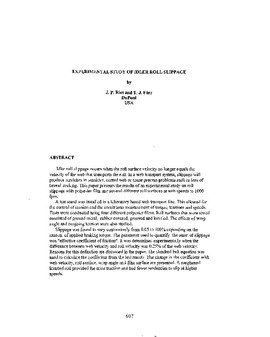| dc.contributor.author | Ries, J. P. | |
| dc.contributor.author | Farr, T. J. | |
| dc.contributor.other | International Conference on Web Handling (1999) | |
| dc.date.accessioned | 2019-11-07T15:30:23Z | |
| dc.date.available | 2019-11-07T15:30:23Z | |
| dc.date.issued | 1999-06 | |
| dc.identifier | oksd_icwh_1999_ries1 | |
| dc.identifier.citation | Ries, J. P., & Farr, T. J. (1999, June). Experimental study of idler roll slippage. Paper presented at the Fifth International Conference on Web Handling (IWEB), Stillwater, OK. | |
| dc.identifier.uri | https://hdl.handle.net/11244/321790 | |
| dc.description.abstract | Idler roll slippage occurs when the roll surface velocity no longer equals the velocity of the web that transports the roll. In a web transport system, slippage will produce scratches in sensitive, coated web or cause process problems such as loss of lateral tracking. This paper presents the results of an experimental study on roll slippage with polyester film and several different roll surfaces at web speeds to 1000 fpm. | |
| dc.description.abstract | A test stand was installed in a laboratory based web transport line. This allowed for the control of tension and the continuous measurement of torque, tensions and speeds. Tests were conducted using four different polyester films. Roll surfaces that were tested consisted of ground metal, rubber covered, grooved and knurled. The effects of wrap angle and outgoing tension were also studied. | |
| dc.description.abstract | Slippage was found to vary continuously from 0.05 to 100% depending on the amount of applied braking torque. The parameter used to quantify the onset of slippage was "effective coefficient of friction". It was determined experimentally when the difference between web velocity and roll velocity was 0.25% of the web velocity. Reasons for this definition are discussed in the paper. The standard belt equation was used to calculate the coefficient from the test results. The change in the coefficient with web velocity, roll surface, wrap angle and film surface are presented. A roughened knurled roll provided the most traction and had fewer tendencies to slip at higher speeds. | |
| dc.format | application/pdf | |
| dc.language | en_US | |
| dc.publisher | Oklahoma State University | |
| dc.rights | In the Oklahoma State University Library's institutional repository this paper is made available through the open access principles and the terms of agreement/consent between the author(s) and the publisher. The permission policy on the use, reproduction or distribution of the article falls under fair use for educational, scholarship, and research purposes. Contact Digital Resources and Discovery Services at lib-dls@okstate.edu or 405-744-9161 for further information. | |
| dc.title | Experimental study of idler roll slippage | |
| osu.filename | oksd_icwh_1999_ries1.pdf | |
| dc.type.genre | Conference proceedings | |
| dc.type.material | Text | |
